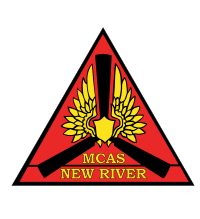Marine Corps Air Station New River
|
MCAS New River McCutcheon Field |
|||||||||||||||
|---|---|---|---|---|---|---|---|---|---|---|---|---|---|---|---|

MCAS New River Insignia
|
|||||||||||||||
| Summary | |||||||||||||||
| Airport type | Military | ||||||||||||||
| Operator | United States Marine Corps | ||||||||||||||
| Location | Jacksonville, North Carolina | ||||||||||||||
| Built | 1943 | ||||||||||||||
| In use | 1943 - present | ||||||||||||||
| Commander | Col. Russell C. Burton | ||||||||||||||
| Occupants |
Marine Aircraft Group 29 Marine Aircraft Group 26 |
||||||||||||||
| Elevation AMSL | 26 ft / 8 m | ||||||||||||||
| Website | www.newriver.marines.mil | ||||||||||||||
| Runways | |||||||||||||||
|
|||||||||||||||
|
Sources: Official website and FAA
|
|||||||||||||||
Coordinates: 34°42′26″N 077°26′43″W / 34.70722°N 77.44528°W
Marine Corps Air Station New River (ICAO: KNCA, FAA LID: NCA) is a United States Marine Corps helicopter and tilt-rotor base in Jacksonville, North Carolina, in the eastern part of the state. In 1972, the airfield was named McCutcheon Field for Brigadier General Keith B. McCutcheon, one of the fathers of Marine Corps helicopter aviation. Near Marine Corps Base Camp Lejeune, it shares some facilities with Camp Geiger.
The base was originally 29 parcels of land, a simple stretch of tobacco farm that was purchased for $64,502 in 1941. Officials at Camp Lejeune investigated the area in search of an existing airfield for hosting aircraft in support of amphibious operations. Capt. Barnett Robinson, a member of Marine Glider Group 71, concluded in his search that the farmland would suit the Marine Corps’ needs.
The location was placed under the command of Marine Corps Base Camp Lejeune and received its first squadron, VMSB-331 from Marine Corps Air Station Cherry Point on March 9, 1943. On June 1, VMSB-331 was divided in half to create VMSB-332. However, both squadrons were soon after relocated to Bogue Field. From mid-1943 through August 1944, Marine bombing squadrons VMB-433, VMB-443 and VMB-612 operating the land-based PBJ Mitchell bomber were stationed there. On April 26, 1944, the area of land around New River and Peterfield Point, named after the original owner of the farmland that was part of the government purchase, was commissioned Marine Corps Auxiliary Airfield Camp Lejeune. This delineated the airfield from Camp Lejeune, and marks its official birth as a separate Marine Corps installation. Over the next few years, paratrooper Marines, glider troops and air delivery personnel were trained in King Air hangar, the Stations’ first hangar, which was transported from Marine Corps Recruit Depot Parris Island, South Carolina.
...
Wikipedia
